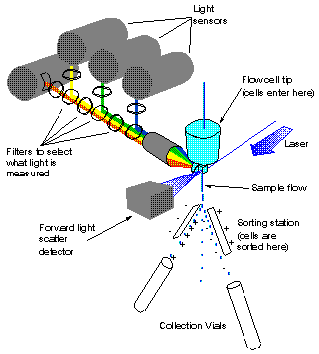Using flow cytometry to study the bacterial cell cycle.
 Diagram of flow cytometry experimental set up from here (which has extensive notes on the theory and practice of flow cytometry).
Diagram of flow cytometry experimental set up from here (which has extensive notes on the theory and practice of flow cytometry).Flow cytometry is a tool for making light scattering and fluorescence emission measurements on individual cells. The equipment can collect data from numerous individual cells passing through the detector and present the collected data graphically. Usually light scattering is measured as an indicator of cell size and fluorescence staining as a measure of some component, such as stained DNA or amount of bound antigen specific antibody that is detectable by fluorescence because it has been coupled chemically to a dye.
Chapter 9 of Schaechter presents data of this type in Figure 9.3.
Fig. 9.3 describes a bacterial culture (probably E. coli) that has been treated with antibiotic rifampin, and then allowed 90 minutes to complete DNA replication before being analysed by flow cytometry.
Study Questions:
What is the target of action of rifampin?
What is the basic model for chromosome replication in these cells?
How can cells have 4 chromosomes?
How do you think DNA content per cell was measured?

0 Comments:
Post a Comment
<< Home